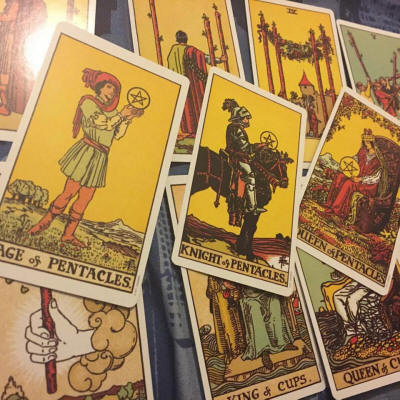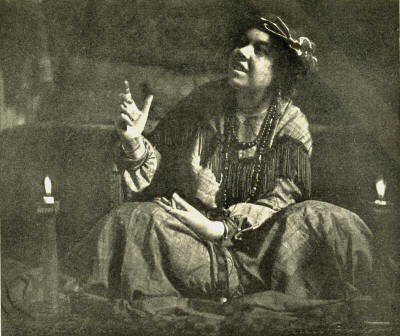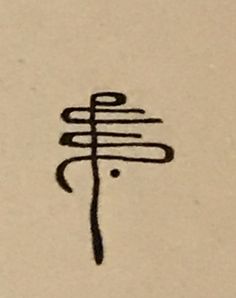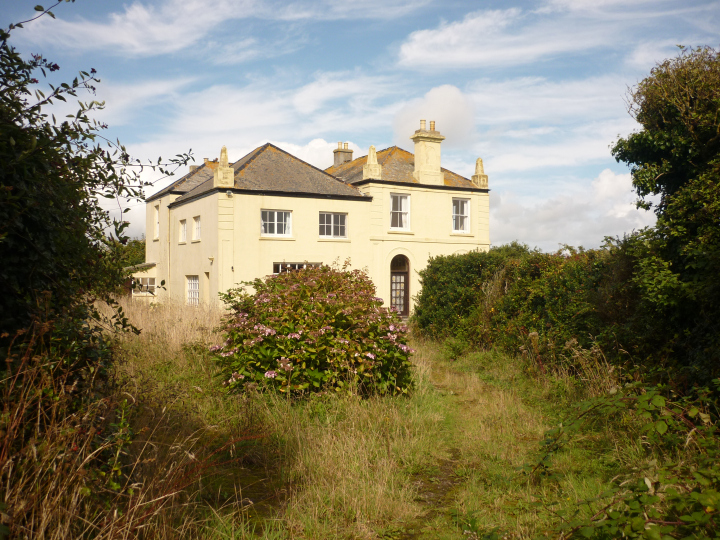|
Pious Pixie: the
life of Pamela Colman Smith
Dawn G Robinson
Investigating the life of Rider-Waite-Smith Tarot artist, Pamela Colman
Smith, made me feel like an imposter: I am not an artist, I am not a
mystic, I am not a Catholic.
While I had no specific theoretical or ideological agenda, I did want to
clarify some assumptions made (stated as fact by some bloggers, but for
which I had seen no real evidence) about the alleged mysticism,
lesbianism, bi-racialism, and synaesthesia of this woman artist who both
fascinated and intrigued me.
I first encountered Pamela Colman Smith (b1878) when commissioned to
write a book entitled Secret Bude. It was only then that I happened upon
the famous Tarot artist, realising she had died in the relatively sedate
but beautiful Cornish coastal town I am so attached to. Pamela (also
known in her earlier life as Pixie) lived her later years here, not too
many miles from brooding Boscastle, the home of the beguiling Museum of
Witchcraft and Magic.
I soon realised that Pamela was more than the sum of her various parts,
and her entire life story could not be told simply via a deck of Tarot
cards, any more than it could by her work with the Lyceum Theatre
(c1900) or her early family background; however, they all played a part
in developing her persona and ever-changing circumstances. Additionally,
most people’s primary focus on her work as a Tarot artist effectively
meant her life, work and potential worth (in the public eye) stopped by
around the age of thirty, which, to me, simply could not be accurate.
Fame is not the only hallmark of success. Pamela lived to be
seventy-three.
The Bude Connection
Pamela’s story was not without some magic in which I was quite prepared
to believe. At a hyperlocal level, the first issue was Pamela’s final
resting place; her burial spot. The exact position was a mystery, and
one which, amazingly, many people found fascinating, such as writers
Stuart Kaplan and Marcus Katz, both of whom had visited Bude on a
mission to find the exact placement of her grave.
Here is where the magic comes in. Back in 2017, a group of twenty-four
Tarot Magic in Merlin’s Britain visitors, led by Mary Greer asked to
meet me in Bude to search for Pamela’s grave, as an unofficial tour
guide. We met at St Michael’s Church, near the historic Falcon Hotel. A
local had advised me of roughly where Pamela was expected to be buried
as a pauper, close to the edge near the woods, in the older part of the
churchyard. We knew she was definitely buried at St Michael’s; however,
the documentation advising exactly where had been lost in a fire many
years before, long before records became centralised in Truro. So, it
was left to imagination and magic to uncover, using dowsing rods and
pendulums.
Science does not accept supernatural powers, suggesting that dowsing
rods are more effective when the operator has some prior knowledge.
Small hand movements (ideomotor) caused by subconscious mental activity
shift the rods up and down, detecting whatever is being sought. Such
divining is an ancient art, however, so I am quite prepared to accept
that people believe they may be guided by supernatural power. I was
prepared to ‘go with the flow’ and let them work their magic. It was in
my interests, too, to find Pamela’s grave but I am not convinced we
could, at the end of it, say ‘X marks the spot’.
 I
was unused to dowsing rods and pendulums to find human remains, but the
group brought theirs with them to do exactly that. They also brought a
medium. The outer corner of the old churchyard seemed to yield a very
positive response. I was bemused to find myself standing in a circle,
each speaking our gratitude to Pamela for creating her lovely Tarot
deck, and all her other art works. When it came to my turn to give
thanks to her, I could only thank her for dying in Bude, which sounded
bizarre, but which is what brought me to her life story. I
was unused to dowsing rods and pendulums to find human remains, but the
group brought theirs with them to do exactly that. They also brought a
medium. The outer corner of the old churchyard seemed to yield a very
positive response. I was bemused to find myself standing in a circle,
each speaking our gratitude to Pamela for creating her lovely Tarot
deck, and all her other art works. When it came to my turn to give
thanks to her, I could only thank her for dying in Bude, which sounded
bizarre, but which is what brought me to her life story.
The group enjoyed a strange happening which those present took to be of
Pamela’s doing. Maybe it was. One of the participants dropped her
pendulum in the spot where the grave was thought to be. She (and I)
heard it hit the ground but no amount of searching found it. It seemed
lost, donated to Pamela. Back on the bus, however, the driver asked if
anyone had left a pendulum behind. There it was.
The group then moved on to the Camelot Hotel at Tintagel, a place where
Pamela had once stayed. In the bar (Pamela liked a drink so would have
approved) the group used the pendulum to ask the mischievous Pixie
whether she had returned it to the bus – the answer was ‘yes’. They also
asked if they had found her burial site and asked many more questions,
which yielded nothing definitive. There was no science or logic to this,
but people viewed it as a sign that Pamela’s spirit was definitely there
with us that day. Maybe the message was ‘stop looking for my grave and
focus on more important parts of my life’.
Meanwhile, some of the visitors also came along to the Bencoolen Inn;
previously flats where Pamela lived and died. Landlady, Lorraine, had
many tales to tell of mischievous ghostly happenings at the Inn; for
example, cutlery being rearranged and reordered. That said, remnants of
the wreck of the Bencoolen are everywhere so the source of such spirits
is uncertain.
A year later, Linda Marson of Global Spiritual Studies followed the same
journey. Her pendulum was the one lost during the previous visit. She
went around the graveyard testing her pendulum in various spots, getting
the answer ‘no’ at places where she knew Pamela was not buried (i.e.,
places with gravestones as Pam’s grave was unmarked). When she returned
to the spot from the previous year, the pendulum turned to ‘yes’. Others
in the group who did not know the site from previously also achieved
‘yes’ responses from their pendulums and dowsing rods.
The Tarot
Pamela enjoys posthumous fame due to her designs for an intuitive Tarot
deck which, worldwide, is said to have over 100 million copies in
circulation. She remains shrouded in aura and mystery, a woman whose
friends and patrons included Alfred Stieglitz and Bram Stoker, but who
sadly, made little money from her work during her lifetime, due largely
to being a woman in a man’s world, which is how the artistic scene, and
life generally, worked in the early twentieth century.
How did Pamela obtain the job of illustrating a Tarot deck? She was an
illustrator/artist, prolific in her output. She also cultivated friends
and contacts, which is how the work came her way. To make a name for
herself, and to make money in order to live, Pamela had to use all her
skills and talents. She needed a unique selling point. She chose
‘difference’.
 In
her younger adult years in bohemian London, Pamela cultivated her sense
of exotic ‘other’, not least as a money- making exercise. She knew many
people but they were not all friends. Pamela, at times, came across as
an outsider, but that helped her to play her role. Times were hard for
single women during the early twentieth century when husbands, even if
wanted, were not always easy to find. Pamela, a storyteller of some
renown, provided soirees or salons for London bohemians seeking
something new and different. Ostentation, colour, vibrancy and
excitement were the order of the day, along with Moorish, Oriental and
Asiatic influences. In
her younger adult years in bohemian London, Pamela cultivated her sense
of exotic ‘other’, not least as a money- making exercise. She knew many
people but they were not all friends. Pamela, at times, came across as
an outsider, but that helped her to play her role. Times were hard for
single women during the early twentieth century when husbands, even if
wanted, were not always easy to find. Pamela, a storyteller of some
renown, provided soirees or salons for London bohemians seeking
something new and different. Ostentation, colour, vibrancy and
excitement were the order of the day, along with Moorish, Oriental and
Asiatic influences.
It is not too surprising that in 1907, a year before her thirtieth
birthday, she was described by Swallows and Amazons author, Arthur
Ransome, as a storyteller, nicknamed Gypsy, who told tales using
Jamaican patois (Ransome, 1907). She dressed the part, calling herself
‘Gelukiezanger’, teller of West Indian folk stories. Ransome described
her ‘mad room’ as if something from a fairy tale. The walls were dark
green, with every available space covered with sketches, paintings and a
double-edged (presumably ceremonial) sword hanging from a hook. The room
was stuffed with loose sheet music, heaps of crimson silk and a
multitude of candles, with incense burning in an urn suspended from the
ceiling. Miscellaneous oddments helped create the exotic atmosphere.
Pamela wore bright robes, her hair tied in an oriental scarf, strings of
coral and amber beads around her neck. She sat cross-legged with five
candles twinkling before her. She definitely put effort into her
appearance and the backdrop, which was a room full of eclectic junk.
Even the drink, claret and lemonade, was given the rather more exotic
name of ‘opal hush’. Pamela, feted for her recital skills, knew
impression management, and how to play an audience, but the events must
have been exhausting, despite being ephemeral.
She mixed with an array of creative thinkers. Pamela’s early friends,
such as the poet W.B. Yeats, about whom she was initially scathing,
added to her sense of mysticism . He introduced her, in 1901, to the
Hermetic Order of the Golden Dawn, leading many to believe she had a
strong interest in the occult. Through the Golden Dawn, Arthur Waite met
her and commissioned the cards. Waite’s biographer, Gilbert, labelled
the Golden Dawn as a ‘society of would-be magicians’, aiming to help
people know themselves through ceremonial magic, which obviously filled
a need of some sort in Pamela’s life at that time. She was also
interested in the Celtic Revival, behind which Yeats was a driving
force. She was fascinated by folklore, creatures such as fairies, the
Sidhe, and other mythologies, so this may have been a time of
self-reflection and introspection for her. In 1903, the Order split with
Yeats joining the Stella Matutina group, while Pamela followed Waite.
She met many members of the occult community in London through
professional contacts and friends, enjoying the social, ceremonial and
ritualistic aspects of the Order (much as she later enjoyed the very
same aspects of the Catholic Church). However, she seemed to drift into
it and within it, not really truly or deeply embracing it. Even Waite
suggested her interest never went ‘subsurface’ . However, despite him
calling her a ‘draughtswoman’ who needed proper guidance (from him) he
was not blind to her artistic gifts, and her work completed the first
commercially available Tarot deck to be produced in Britain. Waite, of
course, took the credit (Waite, 1938).
History has treated Pamela as Waite’s pawn (only left to her own
artistic and imaginative devices to illustrate the pip cards/Minor
Arcana). It is believed that she probably used the Sola Busca deck for
inspiration for this. However, she did not really complain; she was
simply happy to sell her work and earn some money. There are few
indications that Pamela was especially mystical but she was prepared to
buy into it if it sold. Take her membership of the Golden Dawn. Pamela
did not progress very far within the organisation, reaching only the
grade of Zelator in the First Order. It is here where she probably first
encountered the Tarot, which of course, was despised as wicked (not to
mention, challenging) by the Catholics (a religion in which she was
increasingly involved as she created the deck).
 She
was also considered by many to have a neurological condition called
synaesthesia, a condition where a sensation in one of the senses such as
hearing, triggers a sensation in another. Pamela’s version (if she had
it at all) involved creating pictures from music. A chameleon, she had
numerous personas, the more exotic of which were crucial to her making
her mark as a single woman artist. Strangeness and promotion of
difference gave her an audience. Synaesthesia was just one way,
according to academic, Kathleen Pyne, that she could conveniently place
herself in the London milieu of English and Irish mystics (Pyne, K
2007). Mysticism then was part of an economic system and Pamela could
see its potential. She
was also considered by many to have a neurological condition called
synaesthesia, a condition where a sensation in one of the senses such as
hearing, triggers a sensation in another. Pamela’s version (if she had
it at all) involved creating pictures from music. A chameleon, she had
numerous personas, the more exotic of which were crucial to her making
her mark as a single woman artist. Strangeness and promotion of
difference gave her an audience. Synaesthesia was just one way,
according to academic, Kathleen Pyne, that she could conveniently place
herself in the London milieu of English and Irish mystics (Pyne, K
2007). Mysticism then was part of an economic system and Pamela could
see its potential.
Most Pamela aficionados are firmly steeped in the Tarot world, so it is
right and proper that their focus is on her illustrations for the
world-famous deck, and on the more esoteric side of her nature, a side
which my book visits but only briefly dwells upon. The rectified Tarot
deck was commissioned by Arthur Waite in 1909 and completed during April
to October. It was something of a contradictory idea. If the Tarot
contains higher esoteric knowledge, then a popular version of this for
everyone is surely its antithesis. However, the deck sealed Pamela as an
artist, even if not in her lifetime.
At the time of her commission, Pamela was paid poorly (a flat rate) and
her name was omitted from the Rider-Waite deck, as was the conventional
nomenclature, but she did include her initials on every card bar The
Fool, as if to make her mark. Her monogram (pictured left) resembles a
caduceus with snake-entwined staff formed by the letter P, overlaid with
C and S. Waite commissioned Pamela as a ‘very skilful and original
artist’ who also had some knowledge of Tarot values and was ‘deeply
versed in the subject’, but reckoned that he had to work hard to stop
Pamela casually picking up floating images (referring to her alleged
synaesthesia) though art historians suggest Pamela probably used this as
a device to retain control of her own work. No one could argue with a
natural phenomenon.
I have been pleasantly surprised that most people are prepared to look
beyond her lasting Tarot art achievement and are interested in the life
of the woman herself, including her later years far removed from her
time with the Hermetic Order of the Golden Dawn. Pamela was either less
of a believer in divination than most people assume, or she had a
massive change of heart prior to her conversion to Catholicism in 1911,
a process which would have taken a period of some years.
The Cornwall Years
As so little was known about Pamela’s later life, I hoped to, but did
not expect to find out more about her Cornwall years. My big
breakthroughs in uncovering more came from a local gentleman, Tony
Edwards, who was Miss Smith’s errand boy in Bude, and via communication
with the Catholic Church through the Plymouth Diocesan Archive. Tony has
since passed away, so it was very fortunate that he agreed to recorded
interviews when I asked. He had never before been prepared to talk to
any researcher about Miss Smith, as he knew Pamela. His memories gave me
great insights into Pamela’s character which would otherwise certainly
have been lost, for he had written nothing down. It was Tony who told me
I really needed to visit the Lizard to truly understand her.
One of the many myths circulating and perpetuated about Pamela was that
she had set up a holiday home for priests on the Lizard in West
Cornwall, having moved there at the end of World War I in 1918. My
investigations showed this to be false, which, in research terms, felt
massive at the time.

She was received into the Catholic Church
in 1911, two years after she completed the Tarot deck. Being received
into the Catholic Church is not easy and would in itself have taken a
couple of years. It is almost certain that Pamela was preparing to
become a Catholic while still working on the Tarot deck for Waite. This,
to me, indicated that her interest in mysticism was limited, that the
job was a paid commission; something she needed as a jobbing freelance
illustrator, rather than due to any great conviction about the Golden
Dawn.
I visited numerous locations on the Lizard which she had known, from
Cadgwith Cove to Kynance Cove . What I uncovered was that Pamela’s life
there was much more difficult and complex than anyone could imagine. She
spent most of her time on the Lizard in a lovely home called Parc
Garland. Here she tried, but struggled, to serve the Catholic mission in
West Cornwall by establishing and maintaining a Catholic chapel adjacent
to the house.
The new owner of Parc Garland (pictured above) is an artist. She was
surprised by the number of obelisks around the property, indicating, she
felt, a retained occult interest, along with a belief that Pixie
continued to read the Tarot in her attic, which had a good deal of paint
on the floor and windows indicating, additionally a lasting interest in
art. The chapel (Pixie’s ‘Cathedral’ and previously a coach house) is
also still there but tumbled down. The book explains in more detail why
I think Pixie made the journey to Cornwall, spending money from her
Uncle Theodore on a property there.
Very kindly, a member of the Catholic History Group revisited Parc
Garland for me as it was derelict when I went. She mentioned to the
owner that she felt Pixie would be pleased to have an artist living in
her house. At that time, she reported feeling the hairs go up on the
back on her neck. If it is Pamela’s spirit, then she seemed at her
happiest in Parc Garland. The new owner mentioned that her husband often
told visitors that the house used to be owned by a lesbian artist (her
sexuality is a common misconception because Pamela lived with her
widowed housekeeper, Nora Lake, after Nora’s husband, Alfred,
predeceased her). She said that every time he repeated this story, she
heard in her head Pamela saying “we were just friends, Nora and I,
nothing more”.
In terms of my own writing experience, I was fortunate to find space at
the studio of an artist friend, Lynne Holehouse, to write and edit. Next
to Bude Canal, Wharf Studio is overseen by St Michael’s Churchyard where
Pamela is buried. Upon the hour, the bells ring out. At the time, they
served to remind me of my ongoing task of unravelling Pamela’s life. One
day, sat in the studio alone, editing, I was trying to work on a
particular chapter. Lynne had created a painting of her representation
of Pamela which sat, as large as life, peering at me as I worked. Every
time I tried to complete a specific task, my laptop would freeze and
refuse to save the work. This repeated a number of times.
On my request to Pamela and threat to give up on her story, it stopped
happening. Make of that what you will.
References
Pyne, K. (2007) Modernism and the Feminine Voice University of
California
Ransome, A. (1907) Bohemia in London Dodd, Mead and Co
Waite, A. (1938) Shadows of Life and Thought Selwyn and Blount
Pamela Colman Smith – Tarot Artist by Dawn G Robinson is
published by Fonthill Media, 2020, available in all good book shops and
online. In 2018 Treadwell’s in London was able to acquire the fireplace
from Parc Garland and re-install it in the bookshop.
originally published in The Enquiring Eye #4.
18.6.22 |



 She
was also considered by many to have a neurological condition called
synaesthesia, a condition where a sensation in one of the senses such as
hearing, triggers a sensation in another. Pamela’s version (if she had
it at all) involved creating pictures from music. A chameleon, she had
numerous personas, the more exotic of which were crucial to her making
her mark as a single woman artist. Strangeness and promotion of
difference gave her an audience. Synaesthesia was just one way,
according to academic, Kathleen Pyne, that she could conveniently place
herself in the London milieu of English and Irish mystics (Pyne, K
2007). Mysticism then was part of an economic system and Pamela could
see its potential.
She
was also considered by many to have a neurological condition called
synaesthesia, a condition where a sensation in one of the senses such as
hearing, triggers a sensation in another. Pamela’s version (if she had
it at all) involved creating pictures from music. A chameleon, she had
numerous personas, the more exotic of which were crucial to her making
her mark as a single woman artist. Strangeness and promotion of
difference gave her an audience. Synaesthesia was just one way,
according to academic, Kathleen Pyne, that she could conveniently place
herself in the London milieu of English and Irish mystics (Pyne, K
2007). Mysticism then was part of an economic system and Pamela could
see its potential. 